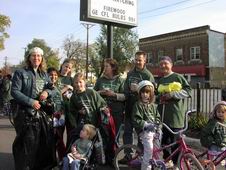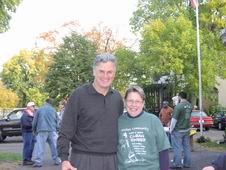Phillips Partnership Honors Officer Jason Okerberg of the Chicago-Lake Beat
Anyone familiar with the Chicago-Lake intersection can testify to the changes that have taken place there over the last several years. Statistics offer the driest version of the story: Phillips has seen overall yearly decreases in crime for some time now, with Chicago-Lake outperforming much of the sector. But the livelier, more interesting tale emerges at the corner itself, where low-octane criminality and rampant hanging out have been replaced with calm, purposeful bustle and flourishing economic development.
One of the most visible agents of this change has been the Chicago-Lake beat patrol, a team of officers specially selected by the Precinct commander to engage in high-contact, community-minded policing at and around the intersection. Recently, the Phillips Partnership awarded a Public Safety Award to one of the beat’s own, Officer Jason Okerberg, who has logged nearly five years at Chicago-Lake. Okerberg is only one of scores of people whose hard work and vigilance have led to the neighborhood-wide reduction in crime in recent years. But in many ways, he typifies the qualities that have led to that success: a belief in the importance of collaboration between the police, businesses and residents; an unshakeable commitment to the neighborhood; and respect for everyone he encounters, from his fellow officers to residents and business owners, and even including the area’s chronic offenders.
As Okerberg describes it, working the beat means connecting with people in the businesses and on the streets. “It’s not like a 911 car,” he explains. “We do backup on domestic calls, but we’re pretty much here for the businesses and the neighborhood, and to keep close tabs on the people who are chronic offenders.” To accomplish that, beat officers spend a fair amount of time hitting the pavement. “That sometimes surprises people, when they see a uniform walking around at Abbott or the Global Market, and that’s a good thing,” he says.
For Okerberg, keeping the watch on Chicago-Lake is about much more than earning a paycheck. “Down here, people know that when I’m here and I’m driving around, this is my neighborhood,” he says. “I don’t live in the city, but in this little area where I work, I want it to be as safe as it is at my own house.” Yet he is quick to deny that he deserves any special recognition for the improvements at the intersection. “Things have gotten 100% better at this corner, but it isn’t because of me,” he says. Inspector Lucy Gerold, who commands the Third Precinct, says that Okerberg deserves more credit than he'd ever take. "Jason is always quick to deflect any recognition or praise for his work," she says. "While it does take lots of partners to keep the area safe, at the core is Jason; we have to give lots of credit to 'Oky’s' leadership, commitment, positive attitude and high quality work. It all radiates from him."
Meanwhile, in typically modest fashion, Okerberg cites the presence of the Safety Center, the cameras, and dedicated police work as key ingredients to the success. He also gives tremendous credit to the perseverance of area businesses and residents who have worked long and hard to make the neighborhood a safer place. “We have a really good community right here in the Phillips neighborhood,” he says. “The grassroots [efforts], with people just trying and trying, and trying again to make things work . . . have gotten much stronger and better here over the years.”
Perhaps because of this, Okerberg recognizes that earning and keeping the neighborhood’s trust is a critical part of his job as a beat cop. “The neighbors and the business owners here are the best resource for helping us out, because they see things that we don’t see,” he explains. “So as long as I can help people to feel that they can come up to us and aren’t afraid, that’s a very big thing.” His approach to patrol work is as direct and forthright as Okerberg himself. “Until you find out that someone has negative intentions, you just treat them with respect and you try to talk to them,” he explains. “And you know, people like to talk, so you just have to let them, and be a good listener.”
That philosophy, coupled with his work ethic and his consistently good arrest records, have led to some very high regard for Okerberg within the force. The ribbing that his colleagues dish out might suggest otherwise, but he is one of the best-liked and well-respected officers on the beat. Renee Allen, CPS of the Midtown Safety Center, attributes that to his essential decency. “Jason is as shy as a stray cat about acknowledging his work, but he is a very kind and caring individual who is also a dedicated MPD officer,” says Allen. “Basically speaking, he is one of the good guys.” Chicago-Lake business owners also give him universally glowing reviews. Tom White of Butler Check Cashing, 827 E. Lake Street, calls Okerberg a credit to the police department. “He’s extremely fair, and very honest, and I trust him a lot,” says White. “He always handles things completely. If somebody has done something and it warrants an arrest, he does it, but he always treats people fairly. I think even the bad guys like him, or at least they know that he’s right.“
With the recent quiet at Chicago-Lake, Okerberg’s patrol duties have now expanded to include other parts of the Precinct. Still, it’s clear that the presence of officers like him will remain an important part of keeping the intersection safe. “I just ran into five guys I used to address all the time a few years ago,” Okerberg recalls. “When my partner and I asked what they were doing, they said, ‘Hey, we’re just getting on a bus, Oky, and we’re out of here!’”
As for the future, Okerberg says that, while he’s open to possibilities, he likes being a patrolman and still enjoys coming to work each day. “Most people probably would say that sometimes I’m a little too excited to be here,” he says with a laugh, “but it is very nice because every day is different and a challenge. And every day I have the chance to meet people and hopefully help them out.”











